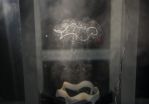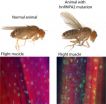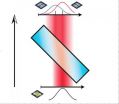(Press-News.org) University of Chicago physicists have succeeding in creating a vortex knot—a feat akin to tying a smoke ring into a knot. Linked and knotted vortex loops have existed in theory for more than a century, but creating them in the laboratory had previously eluded scientists.
Vortex knots should, in principle, be persistent, stable phenomena. "The unexpected thing is that they're not," said Dustin Kleckner, a postdoctoral scientist at UChicago's James Franck Institute. "They seem to break up in a particular way. They stretch themselves, which is a weird behavior."
This behavior culminates in what the UChicago researchers call "reconnection events." In these events, the loops elongate, begin to circulate in opposite directions, move toward each other and collide (the reconnection). Parts of the vortices then annihilate other parts, changing their configuration from linked or knotted into one that is unlinked or unknotted.
Kleckner and William Irvine, assistant professor in physics, report their findings on the creation and dynamics of vortex rings in Nature Physics, published online Sunday, March 3. Their work relates to
deep questions in a variety of physics subfields, including turbulence, plasma physics, ordinary fluids and the more exotic superfluids. Knotted structures are thought to occur in all these phenomena but are difficult or impossible to observe.
"We look at plasma physics and turbulence every day in the sun," Irvine said, yet such phenomena pose longstanding, unsolved scientific puzzles. But knots may offer a means of untangling the complicated behavior of the electrically charged gas in plasma flows, for example, and for understanding the energy transport of complex flows in regular fluids and superfluids.
Conservation of quantities like energy and momentum are among the most important principles in physics. In many systems, the degree of "knottedness" can be represented as a precise physical quantity that also is conjectured to be conserved. "If confirmed, this would deepen our understanding of the dynamics and connections between many disparate physical fields," Irvine said. "We don't know if its true or not, but I think we can finally test this in experiment. There's actually around 50 years of theory on this subject with no clean experiments."
Colliding smoke rings
Irvine became interested in knot physics as a postdoctoral scientist at New York University after watching a smoke-ring demonstration in Washington Square Park. He wondered if he could get colliding smoke rings to become tangled. After unsuccessfully trying to make them himself he learned that others had tried before and failed.
"At some point the enthusiasm wanes and you worry about whether there's a very good reason why nobody has ever done this," Irvine said. "But sometimes going into a new field with a little naivete can be helpful."
VIDEO:
University of Chicago physicists explain how they successfully created vortex knot in the laboratory, a feat that had long eluded scientists.
Click here for more information.
Seeing a video of dolphins blowing air-core vortex rings convinced Irvine of the feasibility of the feat. He tried again, with Kleckner's assistance, soon upon arrival at Chicago. "Before we built the lab we had this little prep room, and we started with a little water tank," Irvine said. They tried to generate rings that would collide and then connect with each other, but the effort "failed catastrophically," Irvine said.
The duo overcame their experimental difficulties by designing and fabricating various hydrofoils (wings used in water) on a 3-D printer. They tried approximately 30 different shapes before they successfully created the desired vortices. When accelerated in a water tank at more than 100 g, hydrofoils leave behind bubble-traced vortex loops, whose dynamics the researchers recorded with a high-speed camera.
"The bubbles are a great trick because they allow you to see the core of the vortex very clearly," Irvine said.
The collaborative intellectual spirit and shared resources of the James Franck Institute also proved critical. "We wouldn't have succeeded without this sort of atmosphere," he said.
Lord Kelvin's knots
The roots of Irvine's work date back to the days of Lord Kelvin, more than a century ago. Kelvin had seen a demonstration of a vortex ring by physicist Peter Tait, and was fascinated by their elegance and stability.
"This was at the time when nobody knew what atoms were and the aether was still in fashion," Irvine said. In Kelvin's day, physicists theorized that the universe was filled with a substance known as aether, which transmitted light waves across the vacuum of space much like air transmits sound through the atmosphere. Kelvin thus proposed that atoms were vortex rings and knots in the aether, where the different types of knots formed the building blocks for the periodic table of elements.
The idea that atoms were simply knots tied in the aether eventually failed. But it failed in such an interesting way, Irvine said, that it gave birth to the fruitful study of knotted systems in mathematics and physics.
In future research, Irvine and Kleckner hope to perform some of their experiments at larger scale to investigate whether size would lend greater stability to vortex rings. They also are investigating the fine scale features of the vortices and whether "knottedness" is, or can be, conserved in fine-scale twisting of the vortex loops. "This is not something we presently know," Kleckner said.
INFORMATION:
Vortex loops could untie knotty physics problems
2013-03-04
ELSE PRESS RELEASES FROM THIS DATE:
Solutions Real Estate's Massive Success and Continued Growth is the Hottest Topic in San Diego Real Estate News Today
2013-03-04
Matt Johnson fell in love with San Diego in 1998, and has resided here ever since.
He is familiar with the local neighborhoods inside and out, and has the ability to assist you in selecting the best one for your family's needs.
Matt got his start in real estate at the age of 9, helping his Dad turn dilapidated old houses into the gem of the neighborhood. He later continued on that tradition, becoming a professional home renovator with operations in two states. Several years later, he realized his passion was in the sales and marketing side, so he obtained his license ...
Researchers discover how to shutdown cancer's powerful master protein
2013-03-04
NEW YORK (March 3, 2013) -- The powerful master regulatory transcription factor called Bcl6 is key to the survival of a majority of aggressive lymphomas, which arise from the B-cells of the immune system. The protein has long been considered too complex to target with a drug since it is also crucial to the healthy functioning of many immune cells in the body, not just B cells gone bad.
But now, in the journal Nature Immunology, researchers at Weill Cornell Medical College report that it is possible to shut down Bcl6 in the cancer, known as diffuse large B-cell lymphoma ...
7 genetic risk factors found to be associated with common eye disorder
2013-03-04
An international group of researchers has discovered seven new regions of the human genome—called loci—that are associated with increased risk of age-related macular degeneration (AMD), a leading cause of blindness. The AMD Gene Consortium, a network of international investigators representing 18 research groups, also confirmed 12 loci identified in previous studies. The findings are reported online today in the journal Nature Genetics. Supported by the National Eye Institute (NEI), a part of the National Institutes of Health, the study represents the most comprehensive ...
Scientists identify 'clean-up' snafu that kills brain cells in Parkinson's disease
2013-03-04
March 3, 2013— (Bronx, NY) — Researchers at Albert Einstein College of Medicine of Yeshiva University have discovered how the most common genetic mutations in familial Parkinson's disease damage brain cells. The study, which published online today in the journal Nature Neuroscience, could also open up treatment possibilities for both familial Parkinson's and the more common form of Parkinson's that is not inherited.
Parkinson's disease is a gradually progressing disorder of the nervous system that causes stiffness or slowing of movement. According to the Parkinson's ...
Adding to the list of disease-causing proteins in brain disorders
2013-03-04
PHILADELPHIA – A multi-institution group of researchers has found new candidate disease proteins for neurodegenerative disorders. James Shorter, Ph.D., assistant professor of Biochemistry and Biophysics at the Perelman School of Medicine, University of Pennsylvania, Paul Taylor, M.D., PhD, St. Jude Children's Research Hospital, and colleagues describe in an advanced online publication of Nature that mutations in prion-like segments of two RNA-binding proteins are associated with a rare inherited degeneration disorder affecting muscle, brain, motor neurons and bone (called ...
Getting around the Uncertainty Principle
2013-03-04
Researchers at the University of Rochester and the University of Ottawa have applied a recently developed technique to directly measure for the first time the polarization states of light. Their work both overcomes some important challenges of Heisenberg's famous Uncertainty Principle and also is applicable to qubits, the building blocks of quantum information theory.
They report their results in a paper published this week in Nature Photonics.
The direct measurement technique was first developed in 2011 by scientists at the National Research Council, Canada, to measure ...
Cancer vaccines self-sabotage, channel immune attack to injection site
2013-03-04
HOUSTON – Cancer vaccines that attempt to stimulate an immune system assault fail because the killer T cells aimed at tumors instead find the vaccination site a more inviting target, scientists at The University of Texas MD Anderson Cancer Center report in Nature Medicine.
A common substance used in many cancer vaccines to boost immune attack betrays the cause by facilitating a buildup of T cells at the vaccination site, which then summon more T cells to help with the perceived threat.
"Vaccines stimulate production of T cells primed to attack the target cancer, and ...
2 new genes linked to amyotrophic lateral sclerosis and related disorders
2013-03-04
A study led by St. Jude Children's Research Hospital has discovered mutations in two genes that lead to the death of nerve cells in amyotrophic lateral sclerosis (ALS), also known as Lou Gehrig's disease, and related degenerative diseases.
The same mutation occurred in both genes and led to the abnormal build-up of the proteins inside cells. These proteins play an essential role in normal RNA functioning and have also been linked to cancer, including the Ewing sarcoma, the second most common type of bone cancer in children and adolescents. The finding is the latest in ...
Study maps human metabolism in health and disease
2013-03-04
Scientists have produced an instruction manual for the human genome that provides a framework to better understand the relationship between an individual's genetic make-up and their lifestyle.
The international team of researchers say their study – published in Nature Biotechnology – provides the best model yet to explain why individuals react differently to environmental factors such as diet or medication.
"This research is the second important stage of our understanding of the human genome," said study author Professor Pedro Mendes, from The University of Manchester's ...
Researchers describe first 'functional HIV cure' in an infant
2013-03-04
A team of researchers from Johns Hopkins Children's Center, the University of Mississippi Medical Center and the University of Massachusetts Medical School describe the first case of a so-called "functional cure" in an HIV-infected infant. The finding, the investigators say, may help pave the way to eliminating HIV infection in children.
A report on the case is scheduled for presentation at a press conference on Sunday, March 3, at the 20th Conference on Retroviruses and Opportunistic Infections (CROI) in Atlanta. Johns Hopkins Children's Center virologist Deborah Persaud, ...


